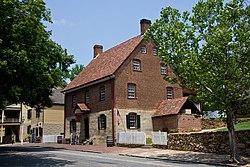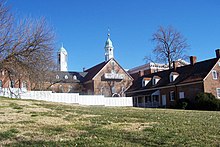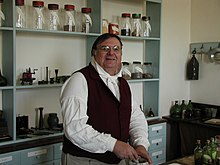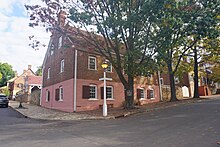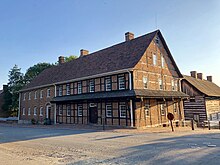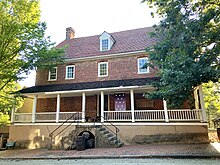
Bethania is the oldest municipality in Forsyth County, North Carolina, United States, and was most recently incorporated in 1995, upon the reactivation of the original 1838/1839 town charter. In 2009, Bethania celebrated the 250th anniversary of its establishment in 1759. As of the 2020 census, the town population was 341.
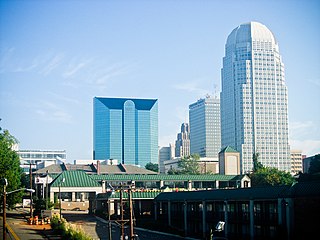
Winston-Salem is a city in and the county seat of Forsyth County, North Carolina, United States. In the 2020 census, the population was 249,545, making it the fifth-most populous city in North Carolina, and the 90th-most populous city in the United States. The population of the Winston-Salem metropolitan area in 2020 was 675,966. It is the second-most populous city in North Carolina's Piedmont Triad region, home to 1.7 million residents.

Kernersville is a town in Forsyth County, North Carolina, and the largest suburb of Winston-Salem. A small portion of the town is also in Guilford County. The population was 26,481 at the 2020 census, up from 23,123 in 2010. Kernersville is located at the center of the Piedmont Triad metropolitan area, between Greensboro to the east, High Point to the south, and Winston-Salem to the west. Some of the farmland surrounding the town has been sold and turned into large middle-to-upper-class housing developments.

Wachovia was the area settled by Moravians in what is now Forsyth County, North Carolina, United States. Of the six 18th-century Moravian "villages of the Lord" established in Wachovia, today only the town of Bethania and city of Winston-Salem exist within the historic Wachovia Tract. The historical tract was somewhat larger than present-day Winston-Salem and somewhat smaller than present-day Forsyth County.

Sunrise service is a worship service specifically on Easter Sunday practiced by some Christian denominations, such as the Moravian Church.

The Moravian musical tradition in United States began with the earliest Moravian settlers in the first half of the 18th century.
These Moravians were members of a well-established church – officially called Unitas Fratrum or Unity of Brethren – that by [the mid-18th century] had already seen almost three centuries of rich experience of religious life. They were spiritual descendants of the Czech priest Jan Hus, who for his attempts at reform was martyred in 1415. Forty-two years later in 1457, some of his followers founded a church body consecrated to following Christ in simplicity and dedicated living.
This newly constituted church developed a rich and orderly ecclesiastical life in the 15th and 16th centuries, but in the Thirty Years War of 1618-48 it was virtually wiped out. In the 1720s a few exiles of this religious heritage, along with various other seekers after truth, found refuge on an estate of a Saxon nobleman named Nicholaus Ludwig von Zinzendorf. There in their village of Herrnhut the ancient church experienced a rebirth culminating in a spiritual blessing on August 13, 1727, in which their former diversity of purpose was welded into one.
In a brief five years, by 1732, that first little village of the Renewed Moravian Church began sending missionaries to all corners of the world. After establishing work in England, the Moravians sent colonists to America in 1735. The initial settlement in Georgia proved unsuccessful, partly because of war between Protestant England and Catholic Spain to the south in Florida. More permanent work was established in Pennsylvania in 1741, with the town of Bethlehem as their chief center. Other settlements in Pennsylvania followed. The Moravians purchased 100,000 acres in North Carolina and settled at Bethabara in 1753 with the central town of Salem being founded in 1766.” [Villages of the Lord]

The Moravian Church in North America is part of the worldwide Moravian Church Unity. It dates from the arrival of the first Moravian missionaries to the United States in 1735, from their Herrnhut settlement in present-day Saxony, Germany. They came to minister to the scattered German immigrants, to the Native Americans and to enslaved Africans. They founded communities to serve as home bases for these missions. The missionary "messengers" were financially supported by the work of the "laborers" in these settlements. Currently, there are more than 60,000 members.
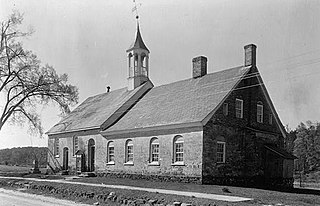
Bethabara Historic District encompasses the surviving buildings and archaeological remains of a small Moravian community, that was first settled in 1753. Located in present-day Forsyth County, North Carolina, it is now a public park of the city of Winston-Salem. It was designated National Historic Landmark in 1999.

Founded as the first Moravian settlement in Wachovia on November 17, 1753, Bethabara served until 1766 as the center of Moravian work in the South. The old historic church was built in 1788. Designed by Moravian administrator Friedrich Wilhelm von Marschall, it is listed on the National Register of Historic Places. Bethabara Moravian Church facility was built in 1788 in what is now Winston-Salem, North Carolina.

Salem Tavern is a historic museum property at 800 South Main Street in the Old Salem Historic District in Winston-Salem, Forsyth County, North Carolina. It was a tavern in the 18th-century town of Salem, which is now part of Winston-Salem. The tavern is owned by Old Salem Museums & Gardens and open as an Old Salem tour building to visitors. Built in 1784 and enlarged in 1815, it was the first entirely brick building in what is now Old Salem, and is one of the oldest surviving brick tavern buildings in the United States. It was declared a National Historic Landmark in 1964.

The Single Brothers' House was built to house the Single Brethren of the Moravian Congregation of Old Salem, North Carolina. It is part of Old Salem Museums & Gardens and open as an Old Salem tour building to visitors. It is located at 600 South Main Street, at Academy Street, on the southwest corner.

St. Philips Moravian Church is the oldest surviving African American church building in North Carolina. The Moravian church was built in 1861 on the east side of South Church Street, near Race Street, in Old Salem, North Carolina. St. Philips was enlarged in 1890 and remained in continuous use until 1952. In 2004 it was restored by Old Salem Museums & Gardens for use as an interpreted building. Currently only worship services are held at the church weekly.

St. Philips Episcopal Church, also known as St. Philips Church, is a historic Episcopal church located on NC 65 and 8 and SR 1957 in Germanton, Stokes County, North Carolina. It was built in 1890, consecrated in 1894, and is a one-story, Gothic Revival style board-and-batten frame building. It features a two-stage corner tower and belfry.
The following is a timeline of the history of the city of Winston-Salem, North Carolina, USA.

The Goundie House is a historic building located in Bethlehem, Pennsylvania. Constructed in 1810 for the Moravian town brewer John Sebastian Goundie, it is believed to be the first brick residence in Bethlehem and the first private home to reflect the American Federal style. The house is now used as a museum and exhibition space and for pop-up vintage shops. It is a contributing property to the Historic Moravian Bethlehem District, which was designated a National Historic Landmark District in 2012 and later named to the U.S. Tentative List in 2016 for nomination to the World Heritage List.
Frank Liipfert Horton was an American antiques dealer and founder-director of the Museum of Early Southern Decorative Arts (MESDA) in Winston-Salem, North Carolina, in 1965. He oversaw the restoration and reconstruction of fifty buildings in the Old Salem and Bethabara historic districts of Winston-Salem from 1950 to 1972.

C. Winkler Bakery is a bakery on South Main Street in Old Salem, North Carolina. Now the oldest continually operating bakery in North Carolina, it was established in 1799 by the Moravian Church, and is named for Christian Winkler, a Swiss-born baker, who began working there in 1807, after replacing original baker Thomas Butner Jr. The building, which now has a landmark designation, was constructed by Salem's master builder and mason Johann Gottlob Krause, shortly before his death. Its first story is built of uncut stone; the upper levels, of hand-made brick.
Johann Gottlob Krause was an American master mason. He built several notable buildings in the Moravian community in today's Old Salem, North Carolina.

God's Acre Cemetery is a cemetery for the Moravian congregation in Old Salem, North Carolina. It is located around 100 yards (91 m) north of the town's Home Moravian Church and also serves the thirteen member churches of Salem's congregation: Ardmore, Bethesda, Calvary, Christ, Fairview, Fires, Home, Immanuel New Eden, Konnoak Hills, Messiah, Pine Chapel, St Philips and Trinity. St Philips has a second cemetery in the northeastern corner of the adjacent Salem Cemetery.
